What is an EDI Interface?
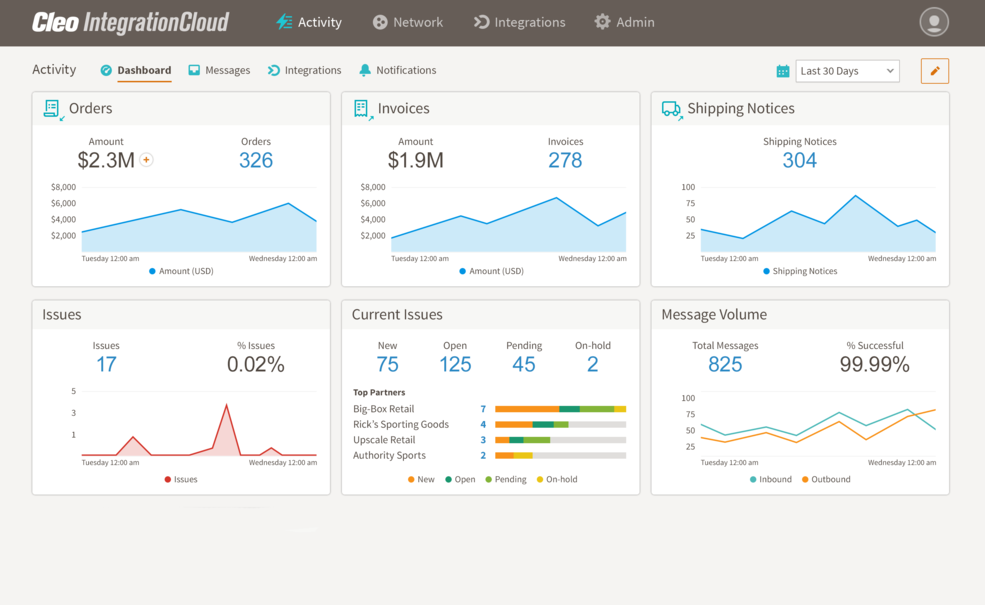
Here is everything you need to know about EDI interfaces:
- What is an EDI interface?
- What does an EDI interface look like?
- Why is an EDI interface important?
- 3 indications that you need an EDI Interface
Although EDI is an older integration technology, its utility for communication between trading partners is undisputed. Every day, companies across the supply chain send and receive millions and millions of EDI transactions. Multinational corporations like Walmart, Amazon, and Target all require their trading partners to trade using EDI to standardize business processes and partner communication.
With the continued importance of EDI as a business-critical communications method, EDI platform technology has become increasingly sophisticated, giving end-users deeper insights and increased visibility over their business interactions.
But, how are these new insights being delivered? What changed?
Enter the EDI interface.
What is an EDI interface?
First, let's revisit the meaning of EDI.
EDI is short for Electronic Data Interchange and is a computer-to-computer communication method that standardizes electronic communication between business partners, such as purchase orders and invoices.
Now, an EDI interface definition:
First, the EDI interface can be defined as the connection point between internal systems (like an ERP or CRM) and the EDI format sent/received. Think of an EDI interface as a software boundary in which EDI documents and internal protocols are converted according to their final destination. For example, an inbound EDI 850 purchase order would be converted into an iDoc as it passes through an EDI interface on its way to being ingested into SAP.
But, EDI interfaces are not just limited to software boundaries. An EDI interface can also be a program or platform that allows end-users to view and interact with EDI transactions, EDI processes, or EDI integrations.
In the same way that traditional user interfaces like the computer keyboard, mouse, or command prompt are used for communication between you and your computer, an EDI interface allows you to directly 'talk to' your EDI software.
Oftentimes, when we speak of EDI interfaces, we are referring to both definitions as they are inherently connected.
What does an EDI interface look like?
Let's have a look at an EDI interface. When business trading partners exchange EDI transactions, that data is sent in the EDI standard format, ensuring that it can be recognized and processed by the destination system.
Here you have a screenshot of the Cleo Integration Cloud EDI interface, in which you can see all of the elements of an advanced EDI interface:
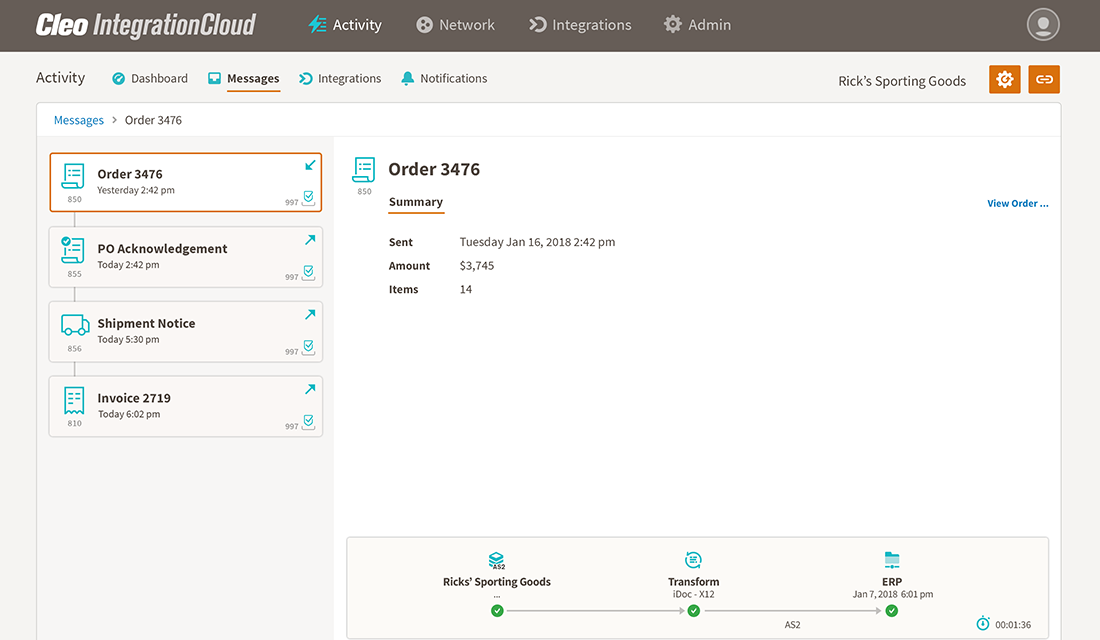
First, at the very bottom of the screenshot, you can see an inbound EDI being transformed from an X12 EDI standard to an iDoc. Next, the iDoc is ingested into the ERP. That boundary between the X12 EDI document and the ERP is the system-to-system EDI interface.
While the system-to-system EDI interface is fundamental to any EDI exchange, the user-to-system EDI interface is where we see the true benefits of an advanced EDI solution.
Next, you can see the EDI interface is showing each transaction in a format that is more aligned with the business process, as opposed to the raw EDI data. Using the EDI interface you can see how the inbound EDI 850 Purchase Order from your hypothetical trading partner, Rick's Sporting Goods, plays into a greater order-to-invoice or EDI order processing cycle.
The following screenshots show that cycle in motion.
Here you have an EDI 855 Purchase Order Acknowledgment, confirming receipt of the EDI 850:
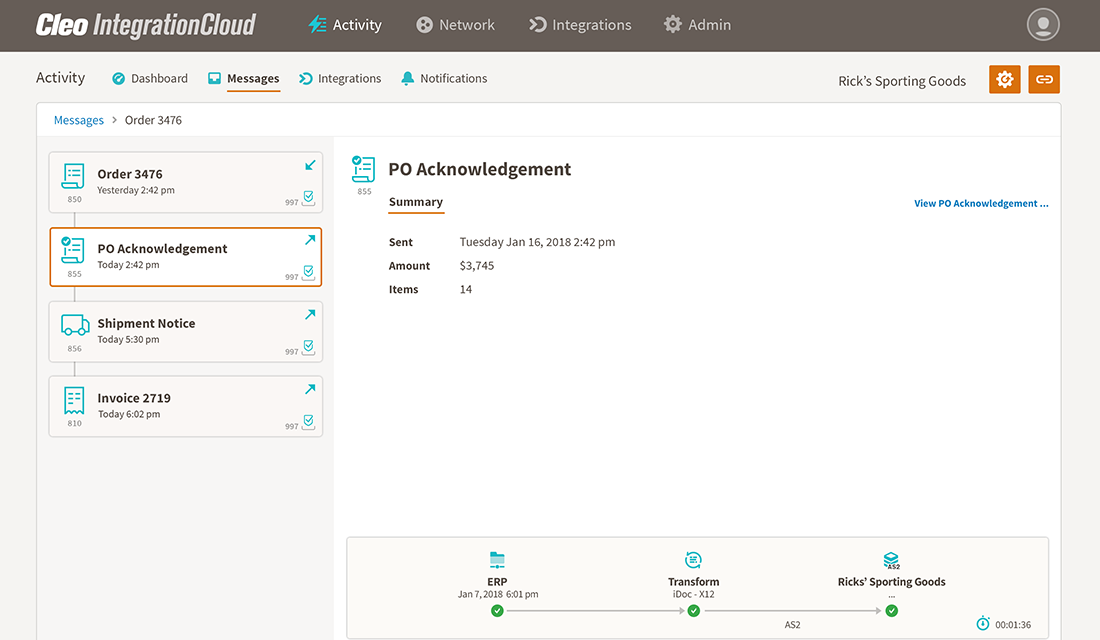
Next, a shipment notice, notifying the trading partner of the shipped item.
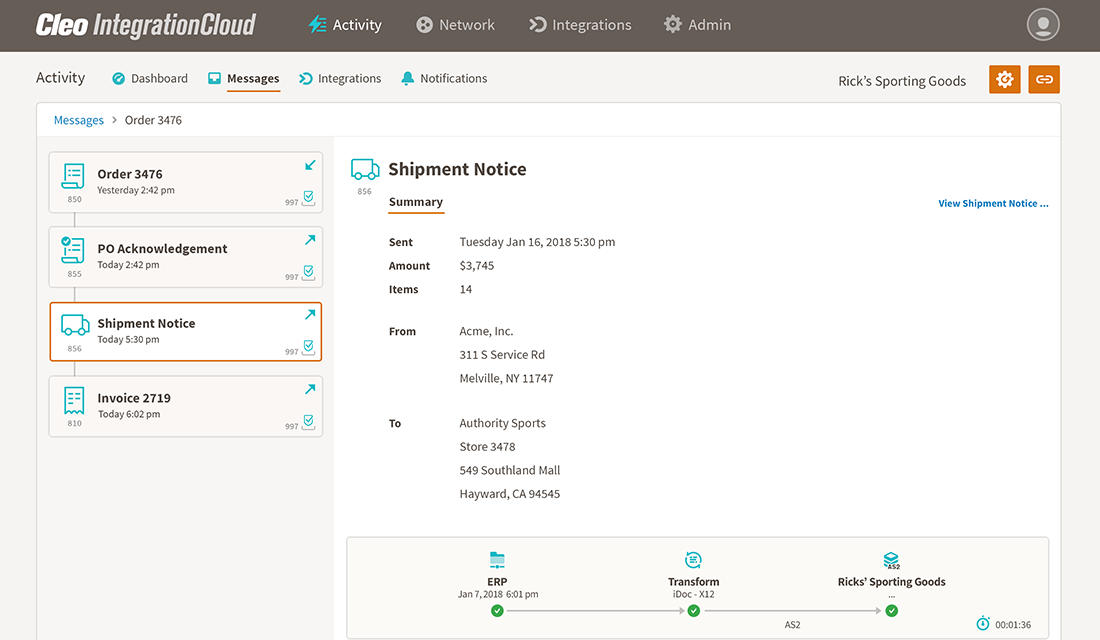
And finally, an EDI 810 invoice completes the purchase order to invoice cycle.
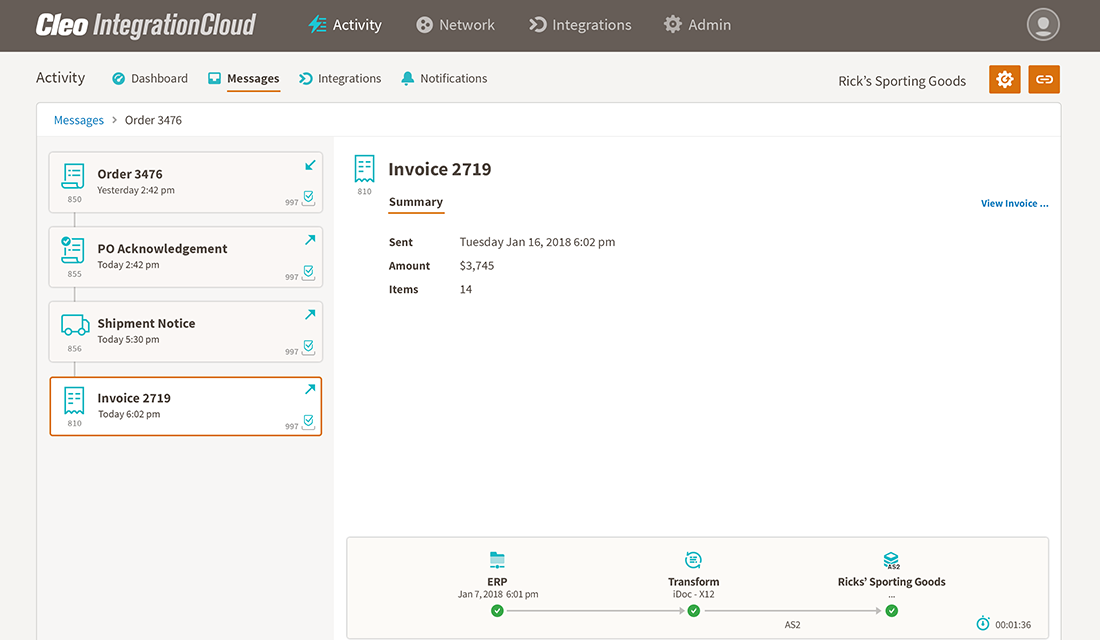
It's one thing to send and receive documents, but a modernized EDI interface takes that user-to-system interaction to the next level of EDI capability. Using a traditional EDI software package, all of these EDI documents would look something like this, without the platform visibility for non-technical users:
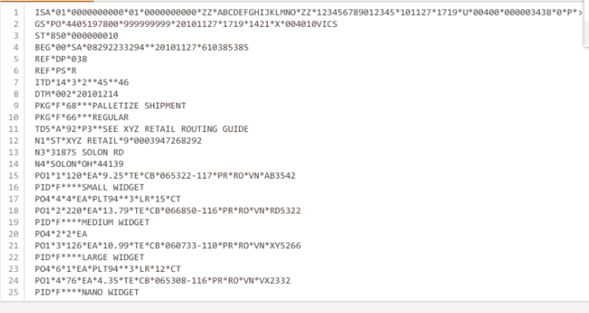
As you can see, while this view may be helpful for technical users, it lacks the business process context of a complete EDI interface, leaving it more or less unintelligible for a person in a non-technical role.
Why is an EDI interface important?
First, a system-to-system interface is important because it's the foundational borderline for communication between an EDI translation system and an ERP.
Without an EDI interface, your front-end EDI software is not 'talking' to your back-end ERP, TMS, WMS, or accounting software. And those gaps can slow down your business processes significantly.
Next, the user-to-system interface is critical because it is the only method for monitoring communication between trading partners.
In particular, for those companies that do a large portion of the majority of their business via EDI, the visibility afforded by an advanced EDI interface is unparalleled in value.
Here are three examples of how an EDI interface can make a difference:
- Issue resolution
- Technical Views
- Comprehensive Process Visibility
Issue Resolution
A modernized EDI interface can enhance issue resolution with automated notifications and exception tracking. In the below screenshot, you can see that an EDI 204 Load Tender Request has failed due to an expired partner certification.
The Cleo Integration Cloud EDI interface has flagged the problem and provides a chat function in which a service member is helping the client re-establish connection:
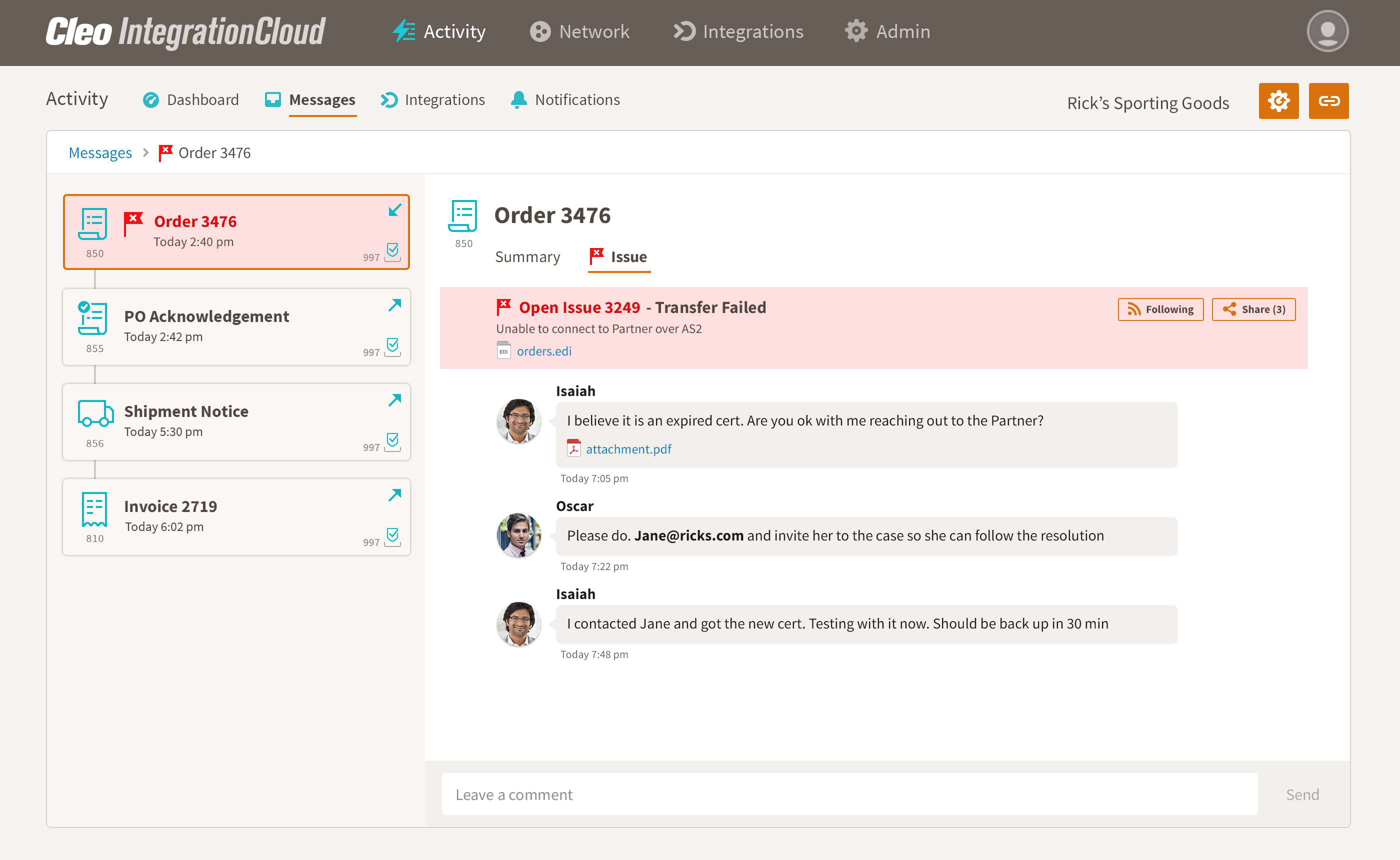
Technical Views
In addition, an EDI interface can better equip technical users to break down basic EDI interactions.
Here you have a screenshot of an EDI 850 purchase order message, alongside the translated version of the message.
If there were an exception or another reason for comparing the two messages, this EDI interface offers a side-by-side view with a simple click of a button:
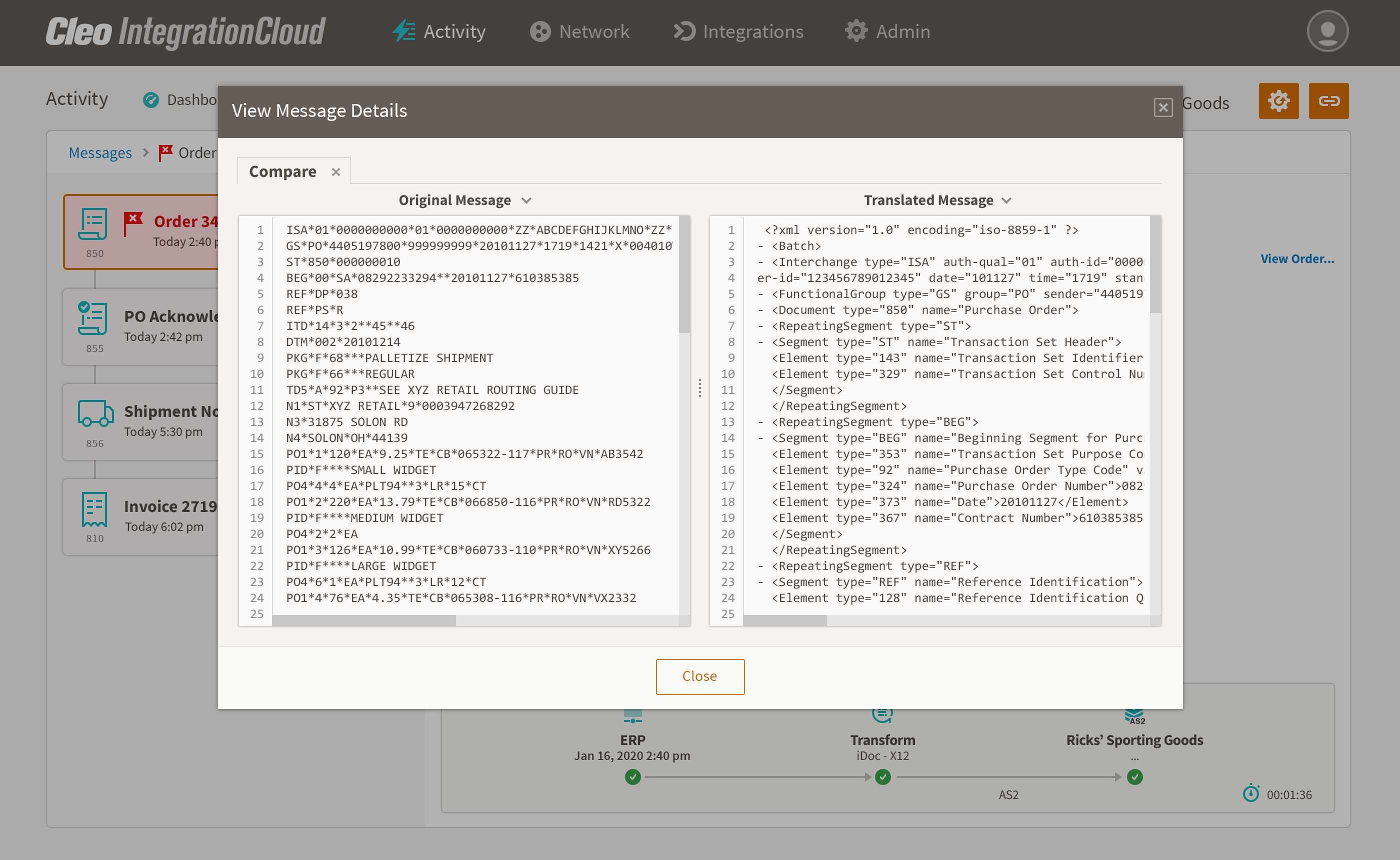
Comprehensive Process Visibility
In this final screenshot, you can see an example view of the home dashboard of the Cleo Integration Cloud EDI interface.
This view gives you a high-level overview of your EDI processes in a simple and easy-to-navigate manner.
Detailed information about your orders, invoices, shipping notice, message volume, etc. is only a click away:

An EDI interface like this one grants your company a comprehensive view of the way EDI drives your business.
3 Indications that you need an EDI interface
- You are in violation of your partner SLA's
- You have no visibility into your EDI processes
- Onboarding trading partners takes too long
SLA Violations & EDI Chargebacks
Violations of trading partner SLA's can be costly. For example, Amazon Vendor Central charges customers up to 6% of the total cost of a product if an EDI 856 - Advanced Shipping Notice is not sent on time or is inaccurate. Even more costly, an unconfirmed Purchase Order costs a trading partner 10% of the total product cost. The price for failing to meet SLA's with Amazon or any vendor can be devastating. If you are consistently in violation of partner agreements and the chargebacks are holding your business back, it's time to think about investing in modern EDI.
Lack of Visibility
Oftentimes businesses will use EDI VAN providers or outdated EDI tools to manage their trading partner relationships. In both cases, a business is likely to run into a problem of a lack of visibility over basic business processes.
With the VAN example, an EDI technician might notice a problem with a partner EDI transaction, but he/she cannot identify or resolve the problem on his/her own. Instead, a ticket must be submitted to the VAN company and the technician is left to wait until the problem is addressed by an outside organization. In short, he/she lacks any kind of view of the EDI interface. Instead, he/she is confronted by a black box that is completely inaccessible.
With a traditional or outdated solution, the EDI interface is likely built on decades-old EDI systems that are stitched together via custom integrations or archaic scripts. The solution may work for simple transactions with a view of trading partners, but even the simplest errors cannot be tracked and EDI documents are traded without understanding their underlying business process value.
Problems with EDI Partner Onboarding
If you struggle to onboard EDI trading partners, part of the problem may be due to an antiquated interface. Trading partner onboarding is an intensive process, with many partner requirements that must be met. With a modern EDI interface, you can take advantage of pre-existing templates to 'copy and paste' trading partner connections or you can quickly create the provisions necessary to establish a connection. Trading partners are bound to have unique requirements and an easy-to-navigate interface helps you to become compliant.
A Modern EDI Interface
If your current EDI interface does not give you a view into your trading partner EDI processes, you ought to embrace a modern integration platform.
Cleo Integration Cloud offers EDI and API integration on the same platform helping you leverage integration for the benefit of not just your company, but your entire business ecosystem.
Discover the benefits of using the Cleo Integration Cloud interface by watching this short demo video:

About Cleo
